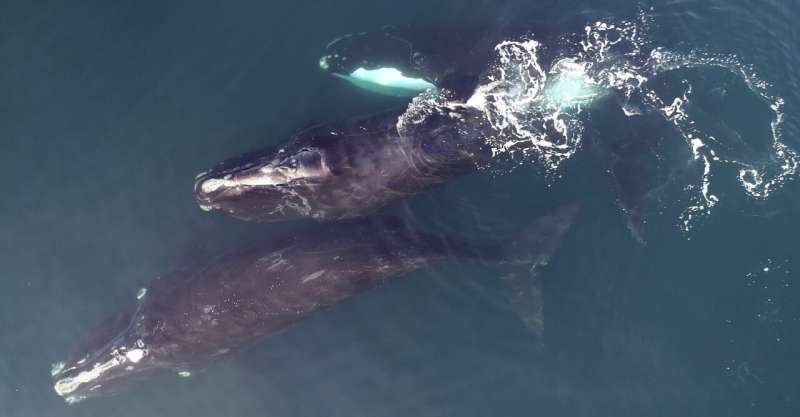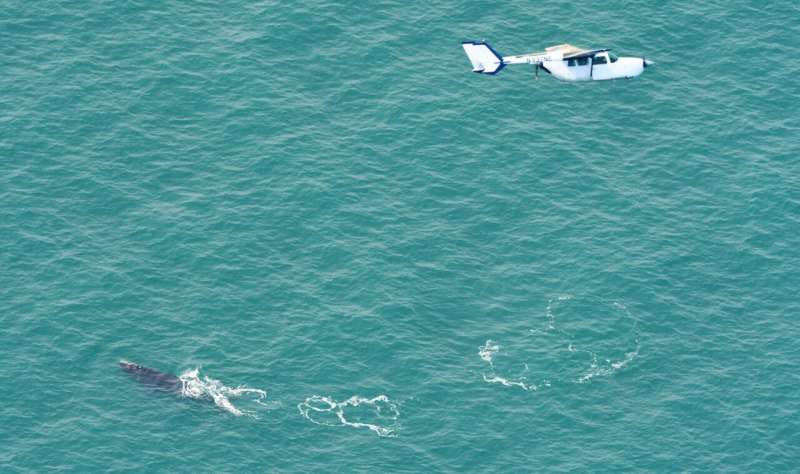This article has been reviewed according to Science X's editorial process and policies. Editors have highlighted the following attributes while ensuring the content's credibility:
fact-checked
peer-reviewed publication
trusted source
proofread
Where have all the right whales gone? Researchers map population density to make predictions

Marine researchers have mapped the density of one of the most endangered large whale species worldwide, the North Atlantic right whale, using newly analyzed data to predict and help avoid whales' harmful, even fatal, exposure to commercial fishing and vessel strikes.
Duke University's Marine Geospatial Ecology Lab led a collaboration of 11 institutions in the United States that pooled 17 years of available visual survey data covering 9.7 million square kilometers of the U.S. Atlantic—roughly the same area as the entire contiguous United States.
This information was coupled with auditory data from almost 500 hydrophone recorders in US Atlantic waters that captured whales' calls. Lining up visual and acoustic datasets for the first time, researchers built a statistical model to estimate the number of whales per square kilometer at different points in time. Researchers published their findings in Marine Ecology Progress Series.
"The more accurate and detailed the mapping, the better chance we have to save dwindling numbers of right whales from preventable injury and fatality," said Patrick Halpin, director of Duke's Marine Geospatial Ecology Lab. The lab studies marine ecology, resource management, and ocean conservation, using data to inform ocean management and governance.
Other current real-time efforts to track and protect the whales from deadly encounters with human activities have been incomplete or ineffective. Electronic tagging can harm whale health, and it is infeasible to continuously monitor more than a small fraction of the population that way.
The statistical model is a revision of a 2016 model that predicts whale density from environmental data, like sea surface temperature. This latest version incorporates new data to reflect whales' changing migration and feeding patterns, including their presence in new areas that lack protection measures for marine life.

"With nearly three times more aerial survey data than we had before, and confirming evidence from the hydrophones, we were able to show how strongly the population has shifted its distribution," said Jason Roberts, a Duke research associate and lead author of the study.
Right whales maintain the health and balance of marine environments and the entire food web through their feeding habits. As climate change has reduced the population of their prey, whale migration patterns have become more unpredictable, increasing the chances that human activities, like commercial fishing, may harm whale health and chances of reproduction.
Using maps obtained by satellite ocean monitoring, or from physical ocean models like the recently published one, researchers can more accurately predict whale density across the U.S. east coast.
The National Marine Fisheries Service, known as NOAA Fisheries, a federal agency within the National Oceanic and Atmospheric Administration, uses this model to assess and mitigate risks to large whales posed by activities such as trap and pot fishing, vessel traffic, naval testing and training, and offshore energy activities.
This research supports NOAA Fisheries' overarching North Atlantic Right Whale Road to Recovery, which describes the agency's efforts to address threats to the species, and monitor recovery progress. In the United States, the Marine Mammal Protection Act prohibits intentional harming or disturbance (known as "takes") of marine mammals by human activity, and limits takes that happen incidentally.
NOAA Fisheries estimates the number of accidental occurrences of whales harmed, and implements measures to minimize harm. Endangered North Atlantic right whales are approaching extinction. Elevated right whale deaths triggered an Unusual Mortality Event in 2017. In recent years, 125 whales have died or been seriously injured, mostly from entanglements in fishing gear and being struck by vessels in both U.S. and Canadian waters.
More information: JJ Roberts et al, North Atlantic right whale density surface model for the US Atlantic evaluated with passive acoustic monitoring, Marine Ecology Progress Series (2024). DOI: 10.3354/meps14547
Journal information: Marine Ecology Progress Series
Provided by Duke University




















